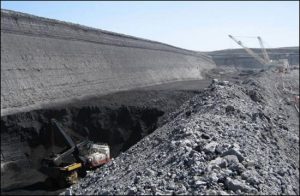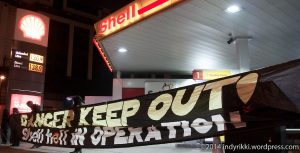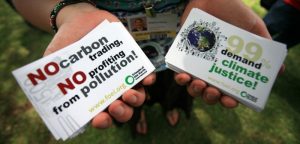Colin Edwards
The use of fossil fuels has led to the production of pollution all around the world and has created several issues because of it. A variety of methods have been created to mitigate environmental hazards or climate change, one of them being the concept of carbon trading, also referred to as emissions trading.
Scientists have made it clear that climate change is a threat and should be of great concern. Dr. James Hansen, a professor at Columbia University stated “If humanity wishes to preserve a planet similar to that on which civilization developed and to which life on Earth is adapted, paleoclimate evidence and ongoing climate change suggest that CO2 will need to be reduced from current levels to at most 350PPM(Parts Per Million).”(350.org) PPM is the mass of a chemical or contaminate per unit volume of water. Our current level of CO2 in the atmosphere is around 400PPM with more being added every year.
How Does Carbon Trading Work?
Carbon trading is a market-based system aimed at reducing greenhouse gases that contribute to climate change, particularly carbon dioxide emitted by burning fossil fuels (BBC). Politicians around the world have largely settled on carbon trading over its rival proposal, carbon taxes, as the chosen method to regulate greenhouse gas emissions. While carbon tax is a fee for making users of fossil fuels pay for climate damage, carbon trading is instead a cap-and-trade scheme whereby an overall limit or cap on the amount of emissions that are allowed from significant sources of carbon, such as the power industry, or automotive and air travel. From there, governments issue permits up to the agreed limit, and if a company was to produce an amount of emissions over this limit they would then have to purchase extra permits. If one was to reduce its emission productions they could then go on to trade their excess permits on the carbon market for cash. The greenhouse gas emissions are measured in a variety of ways and different levels of accuracy. In an industrial setting, continuous emissions monitoring system directly monitor flue gases for carbon dioxide and other gases. Less accurate emissions estimates are calculated based on surrogate measurements, such as the number of kilowatt hours of energy produced or miles driven (Nature).
Carbon Offsetting
The idea is, as long as we stay under the limit given, the amount of emissions produced does not matter and we maintain the 350PPM goal. Carbon trading is intended to encourage those who pollute to create methods that reduce their emissions and can use those results for profit. While there are many examples of carbon trading indeed reducing the amount of emissions produced in certain areas, many problems can be identified in this system, one of them being offsetting. Offset permits are created when a company claims to remove or reduces their emission production which gives them a permit that can then be sold to a polluter to allow them to emit more. The problem is there is not a guaranteed way to confirm or verify that real carbon is being removed which in turn creates the permit. These false offsets encourage companies to produce even more emissions instead of maintaining a stable level. This creates a system that encourages pollution and raises our emission levels because in the eye of the polluter they are simply balancing out their pollution when in reality they are only adding more. A false sense of progress is a step in the wrong direction when it comes to such a detrimental crisis like climate change. (Sarah)
Kyoto Protocol and EU Emissions Trading Scheme
The Kyoto Protocol is a 1997 agreement within the United Nations Framework Convention on Climate Change which commits countries by setting internationally binding emission reduction targets (FERN). The European Union (EU) is one of the groups of countries that participate in the Kyoto Protocol system. Beginning in January 2005, the EU Emissions Trading Scheme (EUETS) goal has been to commit to a reduction target of 20 percent below 1990 levels by 2020. The EUETS included elements from carbon dioxide emissions trading schemes which originated in the United Kingdom and in Denmark, which then set targets for emissions from energy intensive industrial sectors such as the energy, cement, pulp and paper industries, and consists of three phases. Phase one was in January 2005 to December 2007. During this time efforts were focused on specifically controlling carbon dioxide, with a tentative goal of a two percent reduction. Permits were given to emitters at no charge and the number of permits issued was based on previous emissions levels, a practice called “grandfathering.” The problem with grandfathering was that domestic industries in each member state lobbied their governments for the maximum allocations possible, which led to an overallocation of permits. Because of this more permits were given out than industries required which lead to an increase in total emissions by two percent from within the industry sectors covered by the EUETS rather than a reduction. (FERN)
Fossil Fuels
If we are to address the climate crisis, carbon trading is not the answer. The goal of reaching 350PPM in our atmosphere has no chance of being reached with a voluntary system utilizing the free market system. The flaws within the system have been shown, and even in the scenarios where carbon trading has been successful, we cannot forget how damaging the use of fossil fuels can be to not only our atmosphere, but also our environment, health, and communities. Starting with the extraction of coal, there are many environmental impacts created from doing so. Coal mining can dramatically alter the landscape of locations affected. Around 60 percent of U.S coal is stripped from the earth in surface mines and the waste from doing so is dumped in valleys and streams. The occupation itself is also extremely hazardous, either leading to death or injuries in accidents and chronic health problems from inhaling the coal dust (UCS USA).  From there the coal is required to be transported. The coal dust is blown off trains transporting the material which can contaminate fisheries, freshwater sources, and farmlands, affecting human health.(Lyon)
From there the coal is required to be transported. The coal dust is blown off trains transporting the material which can contaminate fisheries, freshwater sources, and farmlands, affecting human health.(Lyon)
The extraction of oil can also be just as hazardous of an occupation for both the workers and the environment.  Increased vehicle traffic at oil drilling sites contributes significantly to noise pollution in wild lands, leading to disruption of wildlife migration routes and habitats (Wilderness Society). The risk of an oil spill occurring is an apparent risk when it comes to the extraction of oil and in the event of a spill the damage caused is difficult to address and can damage animals’ organs, cause cancer, immune system suppression, and lead to reproductive failure (Wilderness Society). When it comes to communities near oil extraction facilities, toxic chemicals and dust can pollute the air and water quality. Open pits, ponds, and lagoons can contain wastewater, organic chemicals, petroleum hydrocarbons and other substances which compromise the safety of water (Wilderness Society). There is also the risk of an oil train explosion occurring near or within a community which is known to occur at an unreasonable rate. The trains transporting the oil were not originally designed for doing so and because of this are filled with flaws that encourage derailments and explosions (Edwards).
Increased vehicle traffic at oil drilling sites contributes significantly to noise pollution in wild lands, leading to disruption of wildlife migration routes and habitats (Wilderness Society). The risk of an oil spill occurring is an apparent risk when it comes to the extraction of oil and in the event of a spill the damage caused is difficult to address and can damage animals’ organs, cause cancer, immune system suppression, and lead to reproductive failure (Wilderness Society). When it comes to communities near oil extraction facilities, toxic chemicals and dust can pollute the air and water quality. Open pits, ponds, and lagoons can contain wastewater, organic chemicals, petroleum hydrocarbons and other substances which compromise the safety of water (Wilderness Society). There is also the risk of an oil train explosion occurring near or within a community which is known to occur at an unreasonable rate. The trains transporting the oil were not originally designed for doing so and because of this are filled with flaws that encourage derailments and explosions (Edwards).
Alternatives to Carbon Trading
A system that encourages the use of these fossil fuels that can create such damaging impacts should not be supported and instead completed avoided. The idea of carbon trading is based on faith, not experience, and we cannot be assured that climate change will end because of it. Whether or not carbon trading reduces emissions production, the damage caused from both obtaining and using the fossil fuels counteracts it completely. A step in the right direction would be a steady progression towards the use of renewable energy such as wind and solar power, a task that will not be accomplished overnight but must be worked towards for the sake of our planet. A sustainable lifestyle is necessary for the amount of people living on Earth and the rate at which we consume resources. This task alone will take time, however a sustainable future does not have a goal to be reached but instead is a lifestyle that everyone needs to get on board with. While certain media outlets convey carbon trading as the solution to climate change and the profits behind it, supporting groups that resist carbon trading is a great way to support alternative methods.
Rising Tide
An example for one of these groups is Rising Tide, which states on its website that it is, “a grassroots network of independent groups and individuals committed to taking action and building a movement against climate change.” Located in the United Kingdom, but with efforts focused internationally, Rising Tide has a wide range of groups that are involved in their network, including student groups, direct action activists, community groups, unions, church groups and energy advice centers. They have a key emphasis on climate change and call for climate justice through methods that address structural inequalities. Rising Tide’s website clearly states it is against the Kyoto Protocol, because “the cuts are far too low and depend on flawed market mechanisms. These will not be effective, will reinforce existing inequalities, and will reward the greatest polluters. The science is clear: to prevent further climate change rich countries need to cut emissions by up to 90%.” (Rising Tide). To help support grassroots action in the UK, Rising Tide has a variety of methods to assist, such as providing trainers and materials for regional workshops in public speaking and community organizing, holding national weekend gatherings each year which brings together people from all over Britain to exchange ideas, experiences, information, and contacts, supporting protesters who “play a crucial role in movements for social change” (Rising Tide). Rising Tide also distributes news and ideas through its website focused around the issue of climate change. It claims that “the real solutions to climate change are undermined by carbon trading.” To see change in our future Rising Tide puts a strong emphasis on educating the public on the importance of addressing climate change and the need for dramatic solutions such as cutting global fossil fuel consumption by up to 60 percent, recognizing the moral and political imperative for fairness and social justice by allocating targets to every country on the basis of equal per capita emissions, and reducing the supply of fossil fuels with an international ban on all new oil, gas and coal development. As a first step, it advocates cutting the $200 billion per year global subsidies for coal and oil power.
Rising Tide has taken many actions to reach these goals such as organizing a national climate march known as “TIME TO ACT” where it gathers supporters for a large march at the Tate Gallery in London to speak their concerns with climate change. At the time four  major institutions, Tate Gallery, National Portrait Gallery, Royal Opera House and the British Museum, were deciding whether or not to renew their sponsorship deal with British Petroleum (BP) (Rising Tide).
major institutions, Tate Gallery, National Portrait Gallery, Royal Opera House and the British Museum, were deciding whether or not to renew their sponsorship deal with British Petroleum (BP) (Rising Tide).
In response to a proposed Helius wood-fired Biomass Power Plant, 11 people from Bristol Rising Tide entered the site spelling out the message “No Biomess” in body paint on their naked torsos. If built, the power station would burn 850,000 tons of imported wood chips each year and contribute to climate change through carbon dioxide emissions and deforestation (Rising Tide).

London Rising Tide blockaded and shut down the Old Street Shell garage on March 14th 2014, in memory of Shell activist and sambaista Val Dazzle, who lost her battle with Motor Neuron Disease in early 2010.  Activists
Activists
handed out leaflets to motorists and passersby which drew attention to areas of Shell’s mass destruction to the environment (Rising Tide).
The group has also organized events such as Climate vs. Capitalism which took place on February 13 of 2016.  The event was created to move on from more theoretical discussions to organizing and action, focusing on specific projects aimed at revitalizing the grassroots, anti-capitalist climate movement in the United Kingdom. The event built off previous workshops from the past to begin action. (RisingTide)
The event was created to move on from more theoretical discussions to organizing and action, focusing on specific projects aimed at revitalizing the grassroots, anti-capitalist climate movement in the United Kingdom. The event built off previous workshops from the past to begin action. (RisingTide)
Friends of the Earth
Friends of the Earth is another group resisting the efforts of carbon trading and speaking out against the flawed theory (FOE Europe). Because carbon trading incentivizes the lowest cost reductions first, and leaves the hardest changes until last, it locks in high carbon infrastructure. Friends of the Earth believe it is time for the European Union to recognize the EUETS system does not work and should focus on other forms of action such as stronger laws to reduce emissions. Introducing national climate laws, developing renewables, and increasing energy efficiency are the first steps towards accomplishing a sustainable future (FOE Europe). Friends of the Earth is currently campaigning for the European Union and national governments to make emission cuts and to invest in real solutions to address climate change, and demands that Europe cuts greenhouse gas emissions by at least 40 percent by 2020 without the use of offsetting (FOE Europe). Its website contains information related to climate change such as climate and energy, corporate accountability, finance, food and agriculture, and resource use. Under each category are news articles from the groups itself related to the topic such as marching against agribusiness megamergers, or the European Union budget not addressing the people and the planet.
Conclusion
Carbon trading may be conveyed as the solution to climate change. However, after seeing the flaws and corruption within the system that lead to a production of emissions instead of a reduction, we must look towards more sustainable alternatives to deal with climate change. If we are to truly make a difference we can no longer support a system that encourages the use of fossil fuels in an “organized” manner that instead focuses on the ability to create profit off our environment. A society that continues to use these fuels will only face the additional burdens created alongside the production of carbon dioxide. Supporting groups such as Rising Tide and Friends of the Earth who wish to transition towards a society that focuses on strictly cutting emission production through a variety of methods is a step in the right direction. A sustainable society avoids the use of carbon trading and steps away from their dependence on fossil fuels, which will take time but should be of great importance to all.
Sources
Cap and Trade * Climate Change * Carbon Market * Carbon Credits * Reducing Carbon Emissions. (n.d.). AltFuelSnow.
Carbon trading: How does it work? (2015, September 25). BBC.
Carter, J. (n.d.). Why Carbon Credits and Offsets Will Not Work. ForestEcologyNetwork.
Case Study 3: Carbon trading in practice – the EU Emissions Trading Scheme. (2012, August 30). FERN.
Center for Climate and Energy Solutions. Climate Change 101, Cap and Trade. C2ES.
Development Dialogue. (2006). Made in the USA: A Short History of Carbon Trading (2006). The Corner House.
Edwards, C. (2016). Oil Trains Issues. Fossil Fuel Connections. Re
Environmental impacts of coal power: fuel supply. (n.d.). UCS USA.
Friends of the Earth. (n.d.). FOE Europe.
Hoag, H. (n.d.). The problems with emission trading. Nature.
Lohmann, L. (2006). Carbon Trading: A Critical Conversation on Climate Change, Privatisation and Power. The Corner House.
Rising Tide. The Case Against Carbon Trading. (n.d.). Rising Tide.
Sarah, H. (n.d). How Carbon Offsets Work. HowStuffWorks.
The Science. (n.d.). 350.org.
Wilderness Society. (n.d.). Wilderness.org





